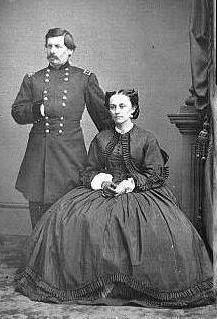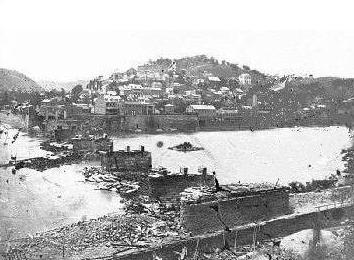
The first attempt of the Union to invade the Southern Confederacy and seize its capital in Richmond ended in disaster on July 21 of 1861, when Confederate forces turned back the Union Army at Manassas Junction in the battle of Bull Run, or (in the South) Manassas.

|
| Major General George B. McClellan, and his wife, Mary Ellen. It is largely through his extremely (if not scandalously) candid correspondence with his wife that we know of McClellan's disdain for the President, the Secretary of War, and many of his own colleagues. Photo from sometime during the war. |
 |
| General Robert E. Lee, at the height of his military career (1863). This portrait is one of three in a series of General Lee, consisting of a standing view, full profile, and this three-quarters left profile, taken by the Richmond photographer J. Vannerson. |
In what is now known as the Battles of the Seven Days, Lee pushed the off-balance McClellan away from Richmond, down the peninsula all the way to Harrison's Landing on the James River. Although each clash could hardly be considered a Confederate victory, the assault so unhinged McClellan that he surrendered his position and allowed the siege of Richmond to be lifted. Unimpressed with McClellan's performance, the authorities in Washington tabled the plans of the peninsular invasion, and began to draw forces from McClellan's army to support the next planned invasion.
The new expedition was headed up by General John Pope, who maneuvered his army along the overland route, south toward Richmond. Lee, decided that McClellan had been neutralized, divided his force, sending part of it, under 'Stonewall' Jackson, north to counter Pope. When it became clear that McClellan's force was being withdrawn, Lee turned his whole attention to Pope. In a series of brilliant maneuvers, between August 9th and 28th, Jackson was able to evade, outflank, get in the rear of and cut the communications of Pope's army. Finally, on August 29th and 30th, the two armies met in full force on the fields of the old Bull Run Battlefield. After a poorly orchestrated battle on Pope's part, his army was thoroughly beaten, driven from the field, and sent streaming back to the defenses of Washington. For the first time in the war, Northern Virginia was swept clean of invaders.
Lee considered his options. The territory he now occupied was stripped bare and he could not remain. He could retreat back toward Richmond, and thereby surrender the initiative and any advantages he now possessed, or he could press his advantage and mount a fully offensive operation.
While Lee pondered, news of the events of the summer's campaigning worked their way to Europe. Great Britain, in particular, saw its advantage in a divided United States, but felt hesitant to intervene until it was sure the South could actually achieve victory. When word of the battle of Second Bull Run reached Britain, she was almost ready to act. One more Confederate victory, and a collection of European powers including Britain and France would almost certainly attempt to intervene, with the possibility of forced separation if no other recourse between the waring parties could be found.
Meanwhile, the authorities in Washington were in a panic. With Pope's army in disarray, there was great fear that Lee might attack Washington itself. Plans were made to move the government to New York and a mood of calamity gripped the city. Wishing to impose order out of chaos, President Lincoln turned to the one man who he felt was capable of returning a sense of trust, confidence, fighting spirit, and organization to the Union army: George B. McClellan. Lincoln's advisers were firmly split on the wisdom of returning McClellan to command. After all, he had shown no initiative on the peninsula, and there was even talk that he had hampered support to Pope, possibly contributing to the defeat at Second Bull Run. Nonetheless, Lincoln was convinced that McClellan was the best choice to lead the country from this crisis, and on September 2, he personally approached McClellan to ask for his help defending the troops in Washington.
 |
| A river crossing on the Potomac, at Berlin, Maryland taken in October 1862. This is the Federal Army, not the Confederate Army; Lee's troops did not use pontoon bridges (as shown in the photograph) while entering or leaving Maryland, but had to wade the swift current of the Potomac at fords which were about four feet deep. |
By September 7th, Lee had moved his army to the vicinity of Fredrick, Maryland. Upon his arrival, he was confronted with an unexpected situation. As he moved north cutting between Washington and Harper's Ferry, he expected the garrison at Harper's Ferry to abandon that position, lest it be cut off from Washington altogether; instead, the Harper's Ferry garrison remained. This presented both a problem and an opportunity for Lee. On one hand, he had hoped to move his line of communications up through the Shenandoah Valley, the mountains providing cover. The force in Harper's Ferry would then lay directly in his path. On the other hand, if the garrison remained in its vulnerable position, it would be ripe for the taking. Since he now knew that George McClellan was to be the commander to pursue him, Lee calculated that he had time on his side. In what would be considered one of his boldest moves, or perhaps his most reckless, Lee decided to break his small army into four parts: three to converge from all approaches of Harper's Ferry (thus preventing any chance of escape) and the fourth to remain with him as the advance party. The overall plan was to be set into motion on the 10th, with all columns accomplishing their mission and reuniting after three days in the vicinity of Boonsboro. Lee issued this plan as Special Order 191.
 |
| Harper's Ferry, photographed late 1861. The railroad bridge shown here in ruins was destroyed in 1861. |
If the plan wasn't too ambitious, it suffered from outright ill-luck. On the 13th, Union troops reached Fredrick (which Lee had by that time abandoned). There, a Union solder found in the grass three cigars wrapped in a piece of paper. This paper ultimately proved to be none other than a copy of Lee's Special Order 191. The amazing discovery quickly passed up the ranks until McClellan received it, no later than evening of the 13th. "Here is a paper with which if I cannot whip Bobbie Lee, I will be willing to go home", McClellan announced. With the knowledge that Lee had divided his army into four parts, and a detailed description of where each was assigned to be, it would be a straightforward matter to meet and crush each of them separately.
As fate would have it, however, McClellan declined to take immediate action on his windfall. Instead of issuing an immediate push to catch the separated Confederate forces, his orders were to move out at daybreak on the 14th. The delay would prove costly.
Lee, meanwhile, was following up on (incorrect) reports of Pennsylvania militia coming down to get in his rear. To counter this threat, Lee divided his army once again, sending most of the advance party to Hagerstown and leaving a small force to guard the South Mountain passes.
Despite the delays and security breaches, Lee's plan to take Harper's Ferry was progressing. The three converging Confederate wings reached the Ferry late on the 13th. Owing to the need to cut paths and move troops and equipment into place, the attack commenced late on the 14th. The Federal garrison of some 13,000 troops, whose commander had been instructed to hold the Ferry at all costs, was in a hopeless situation, possessing no good high ground and surrounded by all sides by the enemy. Although behind schedule, SO 191 was meeting its objective.
Meanwhile, early on the 14th, the rear guard of Lee's army was about to find itself in a tight spot. General D. Harvey Hill was assigned to occupy the South Mountain passes while the Harper's Ferry operation was in progress. Very soon after daylight, Hill discovered that McClellan's slowness and caution had been greatly overestimated. Spurred on by the discovery of SO 191, McClellan's right wing, headed by General Ambrose Burnside, had moved out at daybreak with the immediate intent to occupy South Mountain. The details of the Battle of South Mountain are beyond the scope of this document, however, the end result is that by the end of the 14th the Federal Army had won tactical superiority in all three major passes of South Mountain. Although they had just barely managed to hang on to the two northern passes (they had been completely been driven out of the southmost pass), it was clear to Lee that he would have to completely withdraw from South Mountain. The unexpected swiftness of McClellan and the tardiness of the Harper's Ferry expedition, had put Lee in a very difficult situation: his army split into several parts in foreign territory with the enemy applying serious pressure. The entire Maryland invasion would have to be called off, and the wings of Lee's army instructed to retreat back into Virginia. After Lee had started dispositions for the retreat, a note from General 'Stonewall' Jackson provided Lee with the good news he had been waiting for: the note read that Jackson was confident that Harper's Ferry would certainly fall early the next day, the 15th. Bolstered by the news, Lee reconsidered his plans to withdraw, and instead issued new instructions. The main wing of the army, now pulling westward down South Mountain away from the Federals, would continue west for about 15 miles and take up a defensive position along a small creek know as the Antietam, just outside Sharpsburg. There they would await the detached portion of the army, which would rendezvous there after Harper's Ferry was taken.
As daybreak opened on the 17th, both sides braced for a battle which could radically fix the course of the war. For the Confederacy, the risk was no less than the complete loss of its primary army. Lee's position along the Antietam was defensively good. If anything should go wrong, however, his back was against the Potomac with only one ford available to him for escape. If his army was destroyed, there would be little to hold the Federals back from overrunning Virginia. Success, on the other hand, would buy more time for Lee to occupy Northern soil and reach his military targets in neighboring Pennsylvania. For McClellan, defeat would almost certainly end his military career. He was not unaware that he had many enemies in the Lincoln administration, who would waste no opportunity to apply more pressure for his removal. Furthermore, McClellan rightly viewed this campaign as an invasion of his country, and if he could be accused of lack of enthusiasm in crushing the rebellion, the same certainly could not be said of his determination to cast the invaders out. Looming above the military interests of both sides, there was the question of European intervention. Another Confederate victory could be the final step needed for Europe to act as an intermediary.